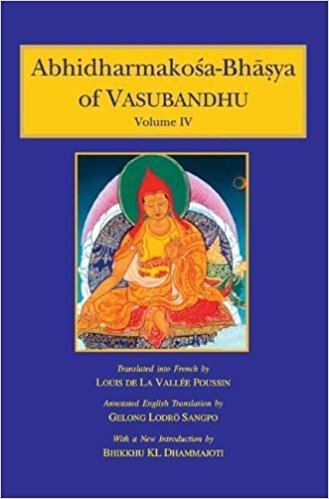Sanskrit Abhidharmakośakārikā | Chinese 阿毗達磨俱舍論
阿毗达磨俱舍论 | |
 | ||
English Verses on the Treasury of Abhidharma Japanese 阿毘達磨倶舎論
(rōmaji: Abidatsuma-kusharon) Korean 아비달마구사론
(RR: Abidalma-Gusaron) Tibetan ཆོས་མངོན་པའི་མཛོད་་
(Wylie: chos mngon pa'i mdzod) Similar Works by Vasubandhu, Other books | ||
The Abhidharmakośakārikā or Verses on the Treasury of Abhidharma is a key text on the Abhidharma written in Sanskrit verse by Vasubandhu in the 4th or 5th century. It summarizes the Sarvāstivādin tenets in eight chapters with a total of around 600 verses. The text was widely respected and used by schools of Buddhism in India, Tibet and East Asia.
Contents
Vasubandhu wrote a commentary to this work called the Abhidharmakośabhāsya. In it, he critiques the interpretations of the Sarvāstivādins, Vaibhāṣikas and others of the tenets he presented in his previous work from a Sautrāntika perspective. This commentary includes an additional chapter in prose refuting the idea of the "person" (pudgala) favoured by some Buddhists of the Pudgalavada school. However, later Sarvāstivādin master Samghabhadra considered that he misrepresented their school in the process, and at this point designated Vasubandhu as a Sautrāntika (upholder of the sutras) rather than as an upholder of the Abhidharma.
Chapters
An English translation of the chapter titles, including the title of the 9th chapter of Vasubandhu's commentary, is:
Karma
Chapter four of the Kośa is devoted to a study of karma, and chapters two and five contain formulation as to the mechanism of fruition and retribution. This became the main source of understanding of the perspective of early Buddhism for later Mahāyāna philosophers.
Vasubhandu elaborates on the causes and conditions involved in the production of results, karma being one source of causes and results, the "ripening cause" and "ripened result." Generally speaking, the conditions can be thought of as auxiliary causes. Vasubhandhu draws from the earlier Sarvāstivādin Abhidharma treatises to establish an elaborate Buddhist etiology with the following primary components:
Six Causes:
Four Conditions
Five Types of Results:
Translations
Ancient translations of the Abhidharmakośa were made into Chinese by Paramārtha (564-567) and by Xuanzang (651-654). Other translations and commentaries exist in Tibetan, Chinese, Classical Mongolian and Old Uyghur; modern translations have been made into English, French and Russian.
English translations include:
Commentaries
There are many commentaries written on this text, including an autocommentary by Master Vasubandhu entitled Abhidharmakoshabhasya. The First Dalai Lama, Gyalwa Gendun Drup (1391-1474) composed a commentary titled Illumination of the Path to Freedom.
The Nalanda scholar Yasomitra, wrote a sub-commentary on the Abhidharmakoshabhasya, the Sputarth-abhidharmakosa-vyakhya.
